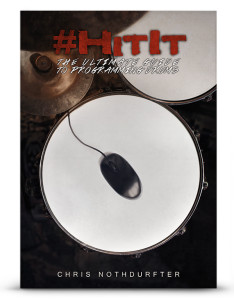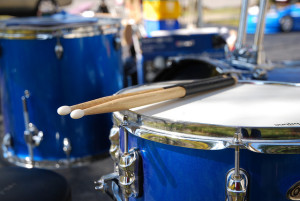The “Locking In” Technique for Programming Authentic-Sounding Drums
Some topics in music production are always good for a heated discussion among musicians, fans and producers:
Should we tune the vocals? Should takes be edited to perfection? Is it okay to copy and paste a good groove from one section to another? Is it okay if we use programmed drums?
As with many controversial tactics in music production, there is a time and place for programming drums.
If you are a songwriter, you’ll appreciate not being dependent on a drummer to complete your demos or songs in your home studio. Drum programming can also be a great option if you lack a good sounding room, quality equipment, or access to solid musicians for a particular recording job.
If you do decide to program drums, or are required to do so for any reason, there are ways to make your life easier and get great results without being a percussion expert.
Where Most People Start
If you’ve been involved in creating music for any length of time, it’s probably safe to say that you’ve figured out the most basic principle of groove creation: The bass drum goes on beats one and three while the snare drum starts out on beats two and four of each measure.
That may not sound like much, but it’s a solid starting point that can get you off the ground reasonably well 90% of the time.
But how do you take it from there and create a drum track that’s specifically custom-tailored to the song you are working on? The answer is a concept I call “locking-in.”
Executing this technique is only barely more complicated than putting the bass drum on 1 & 3 and the snare on 2 & 4, but it will give you a unique drum groove that takes into consideration what the guitars, the bass, or even the vocals are doing in any particular song.
Drum Programming 2.0: “Locking In”
Here are the 4 simple steps of the “Locking In” technique that will help make sure your programmed kick and snare pattern feels custom-tailored to the some you’re working on, even if you’re not a drummer. You can always take these ideas even further, but this simple 4-step process will give you a great starting point every time:
STEP 1 – FIND THE RHYTHMIC HOOK:
The first thing you need to do to create a customized groove is to figure out what instrument in the arrangement, other than the drums, is driving your primary rhythm.
Most of the time this will be the guitar, but it can also be the bass or the vocals. In more complex arrangements it could also be the keys, a brass section. Whatever instrument plays your rhythmic “hook”.
Keep in mind that the driving element may change from section-to-section of the song, so you may want to try this whole approach once for each new section in the song.
STEP 2 – CREATE A GUIDE TRACK:
Once you’ve decided which instrument you’d like to base your drum pattern on, it’s time to re-create its rhythm in the MIDI editor of your DAW.
I find it’s best to do this using a closed hi-hat sample. Every time the main rhythmic instrument hits a note in the bar, you’ll write in a hi-hat hit. Note that the goal here isn’t to create your final hi-hat rhythm—just a guide track to help you build the beat.
If the rhythm seems too complex at first, you can always take it bar-by-bar, or figure it out by clapping along to the driving element, slowing it down in your head until you are able to identify all the individual beats. Another good approach is play along to the pattern using a MIDI keyboard and snap these hits to the grid.
Now you have a “drum groove” template that consists only of closed Hi-hat hits. That’s probably not what you were looking for in an end result. So what’s next?
STEP 3 – REPLACE THE GUIDE TRACK WITH KICK & SNARE HITS:
First, place Snare drum hits on beats two and four. Then, add bass drum hits to all the other beats where you have hi-hat hits, not including the beats where you already have a Snare drum.
Congratulations, you just transferred the rhythm of the driving element into a Bass and Snare drum pattern!The last part of this step is to completely remove the Hi-Hat guide hits so that you are left with nothing but your bass and snare drums hits.
STEP 4 – COMPLETE YOUR GROOVE:
In order to complete your groove, all you need to do it to add the accompanying percussion element of your choice. This could be an open or closed hi-hat, a ride cymbal, or in some cases, Toms—Whatever best suits the particular song you are working on.
For this supplementary element, use a straight pattern—just ¼ or ⅛ notes.This element is meant to serve as a reference point for where the beat lies. In contrast to the rhythm driving elements (the Snare and Bass drum) you don’t want this part of the groove to be all over the place at this stage in the game.
And there you have it: That’s how you can easily create a programmed drum track that’s custom tailored to the specific song you’re working on.

A completed drum pattern in Cubase’s MIDI editor using the “locking in approach”. In this particular case (a heavy metal track) the 16th-note guitar pattern at the end of each phrase inspired a 16th-note double kick pattern that suits the song perfectly.
Enhancing Your Programmed Drums
Even though this is not exactly a beginner’s technique, there’s still a lot of room for improvement. For example, you could try switching some of the bass drum hits with snare drum hits to accentuate different parts of the groove. There are also quite a few steps you can take in order to make your drum track sound realistic, as if a real drummer played it. Small variations in velocities and quantization are the key to achieving that.
Once you’ve got a handle on the basic technique, it can also be a good idea to include small variations in the groove itself so that not every verse or chorus sounds exactly the same. And last but not least, fills can help transition from one part of a song to another.

Chris Nothdurfter is the author of “#HitIt – The Ultimate Guide to Programming Drums.“
As with most areas of music production, there are seemingly infinite options once you get the hang of it, but it helps to have a good place to start. I’m confident that with the “locking-in” technique of matching the driving instrument of your arrangement, you will have a head-start and a solid foundation to build on as you begin to explore programming drums for yourself.
If you have any questions in regards to drum programming feel free to tweet at me @Cnothdurfter any time. If you want a great step-by-step system for learning how to program drums from the ground up (even if you have no prior experience) you can try my book “#HitIt – The Ultimate Guide to Programming Drums.
Good luck!
Please note: When you buy products through links on this page, we may earn an affiliate commission.







